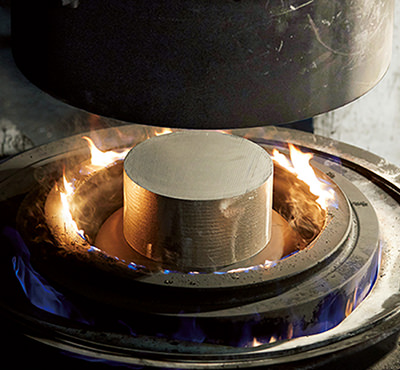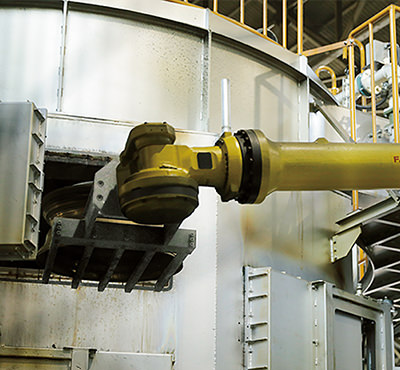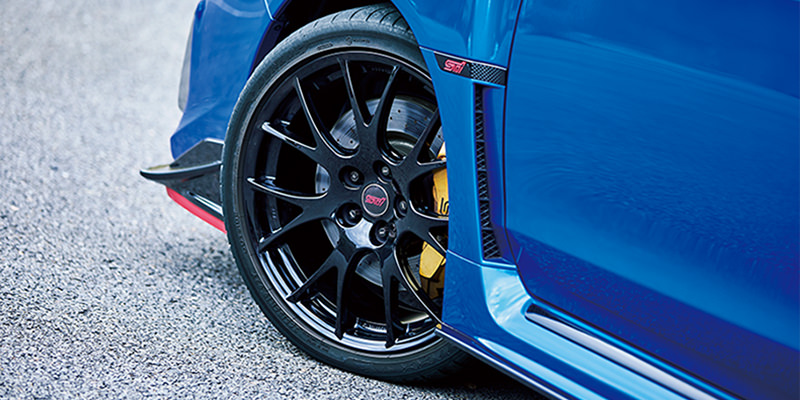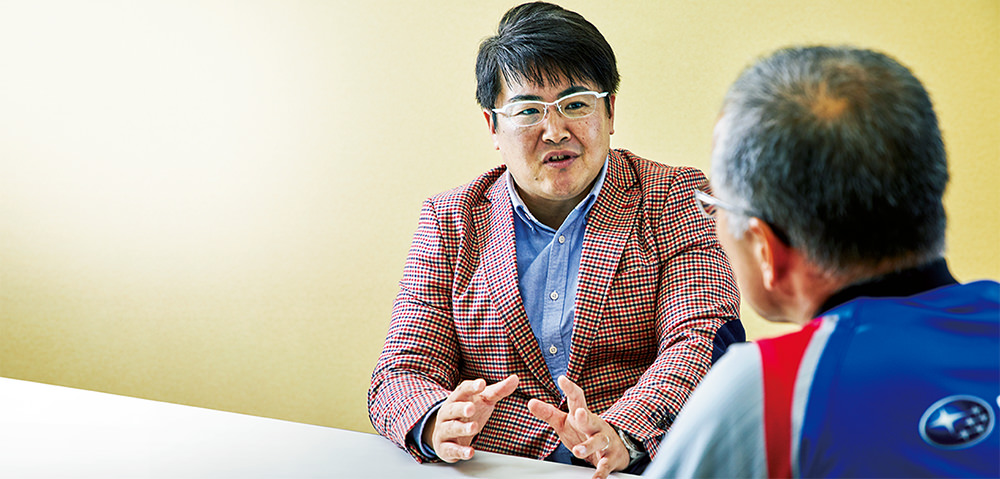
What do in the auto industry professionals currently want from BBS? What would they like to see the company do in the future? Automotive journalist and researcher Shinya Yamamoto interviews Makoto Shibuya of Subaru Tecnica International Inc. about superior Subura handling, building the Complete Car, and his team’s approach to motor sports.
To maximize driving performance,
BBS was the essential choice
Yamamoto Using BBS wheels changes the way an automobile drives. What first showed me this was a Subaru vehicle. Journalists had the opportunity to test-drive the 3rd-generation WRX STI GRB with both regular wheels and BBS wheels and compare. The BBS wheels clearly provided a better driving experience. When I shared this impression with a Subaru engineer, I was surprised to learn that, apart from the wheels, the cars had the exact same specification. Subaru was one of the first Japanese automakers to use BBS wheels as standard equipment. I understand that you tried a wide variety of wheels and that BBS was the standout.
Shibuya Wheels are critical to safety, and they need to be strong enough not to deform excessively or leak air. If they fulfill without compromise this fundamental requirement, then lightness is next as an extremely important performance characteristic. Many factors contribute to steering stability and ride feel, such as the tires, wheels, suspension, body, and aerodynamics. But my personal perspective is that it’s crucial to consider first the parts closest to the road surface and work upward from there. Tires have evolved greatly over the past 10 to 20 years, but the wheels support the tires, and we need to look at them very carefully to maximize driving performance.
Yamamoto What impression did you get from your testing of BBS wheels?
Shibuya My impression is that BBS wheels bring out superior performance from the tires. They help us achieve at a very high level the driving performance characteristics we pursue, such as smooth movement the instant the driver changes the steering angle, continuous and natural steering feel, excellent grip during cornering, and a linear road feel. Since transferring to STI, my thinking has remained the same. For our STI Complete Car Series S, we have striven to deliver performance and elegance that works anywhere, from city streets to the Nürburgring itself. In order to do so, BBS wheels have been an indispensible item.
Yamamoto As soon as you get behind the wheel you sense that the Complete Car S Series offers more than just absolute performance. It also has a very sensual quality that the numbers can’t express. It feels like a sports car and a premium vehicle in one. You don’t have to be running full-throttle on the circuit to experience this, either. Simply make a turn at an ordinary intersection, and it’s clear. Even a single turn reveals something cool. What differences have you observed between BBS wheels and other brands?
Shibuya BBS delivers the right balance between rigidity and lightness, as well as a strong grip on the road. All wheels deform to some extent during driving, but there’s a big difference between sudden and smooth deformation, and this greatly affects driving feel. Further, not all forged wheels are the same. There are differences in the aluminum used and manufacturing methods such as heat treatment and the way force is applied and temperature is managed. BBS has important proprietary know-how. Even with the same machines and the same materials as BBS, no one could obtain the same performance levels.



Race cars and production vehicles demand the same level of functionality
Yamamoto At BBS, the same artisans use the same technology in the same factory to develop and produce wheels for both race cars and production vehicles. I’ve really been impressed by the level of vision at BBS and the outstanding skill of the company’s artisans.
Shibuya One basic test we have of steering stability is the basic suspension characteristics test. We fix the car in place, put force on the tire tread, and measure rigidity. In the case of BBS wheels, we’ve found that rigidity varies not much at all whether the spokes are pointing directly downward or not. I think this quality contributes to smooth, responsive, and linear motion.
Yamamoto Perhaps that’s the secret to the exceptional balance of BBS wheels, which makes them so perfectly merge with the car as a whole. When BBS wheels are put on a vehicle, they instantly give the impression of being standard equipment. And in terms of design, even as the times change, they retain their timeless beauty. The unique shape of the spokes is more than a good look. They are born of the science of mechanics, the enhancement of rigidity balance and ensuring that there are no weak points or overly strong points. I think you could call it functional beauty in pursuit of top performance. Do BBS wheels have any demerits?
Shibuya In my experience, in terms of functionality, they do not. If I had to point out something, some past BBS wheel models had extremely fine spokes, and they were quite a pain to get clean when washing the car [laughs].
Yamamoto Currently, STI is participating in SUPER GT and the 24 Hours Nürburgring with a works team, and you’re using BBS wheels exclusively. What would you say is the difference in performance required of wheels for race cars and for production vehicles?
Shibuya Actually, there’s no difference. It’s all a matter of maximizing performance for both kinds of vehicle. We work with BBS to develop our racing wheels. We’ve improved our times on the track, of course, but I’m also hearing from drivers that wheel enhancements are helping them more easily ride up on the curb during cornering. Wheels have also become more gentle, thanks to the toughness that the forging process imparts. Further, in both, we’ve had no trouble from the wheels whatsoever. This level of trust is a big deal to us.
Yamamoto BBS engineers tell me that STI has very clear and detailed requirements when it comes to wheels.
Shibuya That’s because we’ve realized that wheels change the way a car drives [laughs]. To bring out the best performance from the driver, what should we do about the car? What should we do about the wheels? I’m constantly asking myself these questions. In coming up with the answers, I’ve found BBS to be a partner we simply can’t do without.

The base for these wheels is the commercially available model RI-A.
- Shinya Yamamoto
- Born in Shizuoka Prefecture in 1975, Yamamoto worked in product planning at an automaker and in development at a tuning manufacturer before becoming a journalist at an automotive magazine. Since becoming an independent automotive researcher in 2013, he has made it his mission to convey the perspectives of both automobile makers and owners in a clear, easy-to-understand way. His areas of expertise are numerous. To report on the state of global automobiles, he has traveled extensively around the world. Leveraging his experience as an engineer, he is a skilled presenter of advanced technology, while his tenure as an editor equips to him communicate effectively about the driving mechanism. Known for his wide and deep coverage of the automotive world, he also reports on motorsports and classic automobiles, as well as a range of obscure and interesting topics. He is also renowned for his ability to understand how automotive engineers feel and encourage them to reveal their true opinions.
- Makoto Shibuya
- Joining Subaru in 1974, Shibuya worked in the development of production automobiles like the WRX STI and BRZ with a specialization in steering stability and ride comfort. In 2011, he moved to STI Product Development as General Manager of the Experimental Division. There he led the development of Complete Cars S207 and BRZ tS, as well as various components. Since 2017, he has been the Project General Manager of STI’s SUPER GT initiative and is overseeing the project in 2018. He enjoys rally, dirt trials, and other motorsports, and is himself a championship-winning driver in the All-Japan Dirt Trial Championship.
